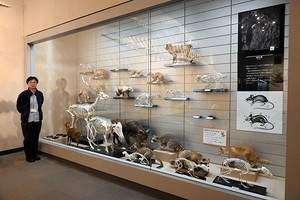By TAKAHIRO KINOMURA/ Staff Writer
April 1, 2025 at 16:52 JST
NAOSHIMA, Kagawa Prefecture—A serious bicycle accident has raised concerns among local authorities ahead of an international art festival on Naoshima, an island known as the “sanctuary of contemporary art” in the Seto Inland Sea.
Bicycles are a common form of transport among visitors to this island with a circumference of only around 16 kilometers.
However, the island is expected to be inundated with thousands and thousands of tourists when the sixth session of the Setouchi Triennale, an event held every three years, opens here in April.
Authorities want to ensure the safety of the visitors, mainly by encouraging them to wear helmets while riding bicycles.
But the response so far has been lukewarm.
SEVERE ACCIDENT OF TOURIST
Police officials have pointed to one particularly dangerous section of a prefectural road on the island, which is under the jurisdiction of Naoshima town.
At around 10:50 a.m. on Oct. 1 last year, a Chinese tourist, 64, cycling along the road crashed after failing to negotiate a downhill bend. His head hit the ground hard, knocking him unconscious and putting him in critical condition.
He barely survived after an emergency medical services helicopter of the Kagawa prefectural government took him to a hospital in Takamatsu, the prefectural capital.
The tourist was not wearing a helmet.
DISTRACTIVE SCENERY
Kazuhiro Shibata, a sergeant with the Naoshima Residential Police Box of the Takamatsu Kita Police Station, said he came across the accident scene while on patrol.
“So many bicycle accidents have occurred around here,” he said.
The site is located along a mountain pass road in the southwestern part of Naoshima, home to the majority of the island’s art spots.
At the highest point of the ascent on the road, the view suddenly opens up, giving cyclists a spectacular vista of the Seto Inland Sea and the urbanized areas of Takamatsu on the opposite shore.
However, after this point, the road turns steeply downhill, and cyclists engrossed by the view could find themselves in danger.
Shibata said at least four bicycle-riding tourists have been involved in accidents on this slope over the last 18 months or so.
They were either moving too fast at the bend or were distracted by the scenery. Many of the tourists were helmetless, Shibata added.
“Wearing a helmet could prevent a serious, potentially fatal injury,” the sergeant said.
SAFETY CAMPAIGN
Visitors on Naoshima island typically need to travel only about 10 km to reach all major tourist spots, including the Chichu Art Museum designed by famed architect Tadao Ando.
Bicycles, including power-assisted ones, are among the principal means of mobility, and several bicycle rental shops operate near ports on the island.
An amendment to the Road Traffic Law, which took effect in 2023, made it obligatory for cyclists to “endeavor to” wear a helmet.
Kagawa prefectural police have created fliers on cycling rules, including the mandatory endeavor to wear a helmet, in nine languages, including English and Chinese. They distributed the fliers to bicycle rental shops across Naoshima in February last year.
Police also prepared a Quick Response (QR) code so cyclists can view the fliers on their cellphones.
“We are showing our customers the prefectural police fliers and other materials to encourage them to wear helmets, but few of them are borrowing one from us,” said the operator of a bicycle rental shop on Naoshima. There is no additional charge for renting a helmet.
However, the operator said he is not going all out to get his customers to wear helmets because bicycle rental shops are under no requirement to do so under the Road Traffic Law or other regulations.
Naoshima town authorities have been trying to notify visitors of Japan’s cycling rules, including using flags to instruct cyclists to “keep left.”
The town government stepped up similar efforts following the serious accident last autumn.
Officials installed around 20 signboards at three particularly dangerous spots on the island to urge cyclists to slow down or to take extra care. They used English text and a drawing on the signboards so that overseas tourists can understand them.
The town’s tourism association said the number of visitors at sightseeing facilities on Naoshima island doubled from around 360,000 in 2009, the year before the inaugural session of the Setouchi Triennale, to more than 750,000 in 2019.
Visitor numbers have rebounded sharply since the end of the novel coronavirus pandemic.
Last year, 749,493 visitors arrived, second only to the 2019 record, even though the Setouchi Triennale was out of session.
“An injury during a journey would spoil happy memories of it,” said Kosaku Maeda, head of the town government’s community development and tourism division. “We hope visitors will cycle safely while they enjoy the charms of Naoshima island.”
HELMETS GIVEN ELSEWHERE
But one bicycle tourism hotspot on the main island of Shikoku is coping with the matter differently.
The Setouchi Shimanami Kaido, a road that extends through islands and along bridges over the Seto Inland Sea from Imabari, Ehime Prefecture, to Onomichi, Hiroshima Prefecture, is known as a “sanctuary of cyclists.”
Shimanami Japan Inc., an Imabari-based general incorporated association that operates bicycle rental businesses along the scenic route, has been lending helmets to all customers since the Road Traffic Law revision.
“We hope to provide more guide materials that are visually intelligible, such as those that combine pictograms with text,” a Shimanami Japan official said, expecting further growth in cycling tourists.




















A peek through the music industry’s curtain at the producers who harnessed social media to help their idols go global.
A series based on diplomatic documents declassified by Japan’s Foreign Ministry
Here is a collection of first-hand accounts by “hibakusha” atomic bomb survivors.
Cooking experts, chefs and others involved in the field of food introduce their special recipes intertwined with their paths in life.
A series about Japanese-Americans and their memories of World War II